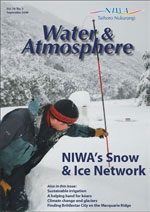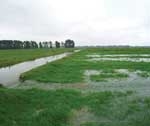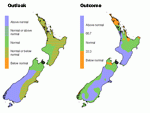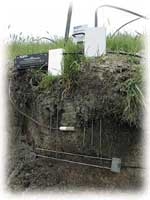PDF of this article (243 KB)




To help farmers get the most out of their irrigation systems, MS Srinivasan and Jochen Schmidt have turned to the TopNet computer model.
Irrigation is like an insurance policy against weather failure, offering the solace of certainty and security for food production. Irrigation also improves the marketability and market value of horticultural produce. So far, so good, but what’s the downside? For a start, there’s a problem of supply and demand.
Many of the current demands on water resources have risen from within agriculture; for example, converting a farm from sheep to dairy, or increasing herd size to increase returns, can significantly alter the irrigation needs. Apart from these internally competing demands, sustainability of irrigation is further challenged by the forecast climate change. Predictions such as warmer climatic conditions and reduced rainfall during growing seasons in the coming years suggest that the water available for irrigation will become even more at a premium.
What can we do in our country’s irrigated areas where the water resource is perhaps already overallocated? What if water becomes even scarcer in thefuture? Can irrigation be sustainable? And at what cost? To help answer these questions, we’ve used soil science and a hydrology model.
Solving the farmer’s dilemma
The farmer faces a couple of primary issues with irrigation: when to apply water to the field and how much water to apply. Often, the farmer’s decision has to be based on the availability of water for irrigation.
For our investigation of the problem, we used the TopNet hydrology model. In simple terms, TopNet is a catchment water-balance calculator. It calculates the water available in various locations – soil, lakes, streams – over time. We operate this computer-based model by setting up scenarios with specified ‘variables’, such as the size of the reservoir, the amount and timing of rainfall, the size of the catchment, the amount and timing of irrigation, and so forth. Then we set the model in motion to calculate how these variables will interact over time.
For our study, we set up two scenarios in which we continuously simulated the water storage status of an irrigation reservoir, the soilwater (moisture) in the irrigated fields, and the fate of the irrigation water supplied. We set our two scenarios in a South Island agricultural catchment and ran them to model four irrigation seasons, 2000 to 2004.
Scenario 1 is ‘unmanaged’ irrigation. Water is applied in a fixed cycle and fixed amount. This approach is typical of flood irrigation, where water is supplied every two or three weeks to the farmer through irrigation races. This scenario uncovers the uncertainty associated with the timing and amount of irrigation, as controlled by the availability of water from the source. In Scenario 2, we introduced a management variable – crop-available soilwater – to control the timing, demand, and irrigation availability.
Unmanaged vs 3M
Under the ‘unmanaged’ conditions of Scenario 1, where irrigation was supplied every 21 days, we found that only a quarter of the water supplied early in the irrigation cycle, during the wet spring season, was stored in the soil for crop use; the rest was lost to streams and groundwater. As the irrigation season progressed, there was less and less water available in the reservoir for irrigation; by summer there was less than a tenth of the water that the modelled agricultural system demanded. This led to extreme dry conditions, where the soilwater available for crop use was reduced to zero. This severe condition recurred every summer in the four years that we modelled.
In Scenario 2 we used a new management approach – monitor-match-manage, or 3M – to better manage and conserve irrigation water. With 3M, the irrigation demand and supply were limited to those times when the crop-available soilwater fell below 30% of its capacity, and the irrigation was stopped when it reached 80% of the capacity. The water-balance calculator indicated that the 3M approach reduced the irrigation frequency by a third compared with the unmanaged scenario, and completely eliminated the irrigation losses to streams and groundwater. All irrigation demands were supplied. Reducing irrigation frequency meant not only that the reservoir was not depleted, but also conserved power where irrigation water had to be pumped. Thus, the 3M approach can save dollars as well as ensuring crops get the water they need.
Two down, one to go
Now that we’ve identified crop-available soilwater as the key factor for determining when to apply irrigation and how much, we shift our focus to the third issue: where do we get the irrigation water when we need it? We’re planning further research to explore opportunities with multiple irrigation sources as well as forecasting the irrigation potential of individual sources. For example, we’ll investigate the use of farm ponds, where excess water can be stored for the times of need. Our results from these studies will help farmers plan their irrigation needs ahead of time and reduce the uncertainty associated with irrigation.
Making every drop count
- Increasing demands – now and in the future – threaten the sustainability of irrigation for agriculture.
- The TopNet hydrology model uses ‘scenarios’ to enable experimentation with water supply and demand.
- With the monitor-match-manage, or 3M scenario, we were able to conserve water and improve the usefulness of irrigation.
Dr MS Srinivasan and Dr Jochen Schmidt are hydrologists specialising in catchment processes and water resources. They are both based at NIWA in Christchurch.
Teachers’ resource for NCEA Achievement Standards or Unit Standards: Agricultural Resource Maintenance Level 3 US17204 Earth Science Level 3 US8153 Education for Sustainability Level 2 AS90811, AS90814, AS90815 Biology Level 2 US6309 Geography Level 2 US11090 Science Level 3 US21613
